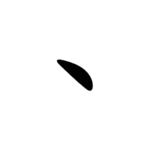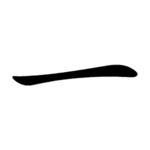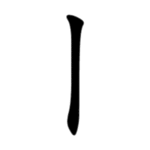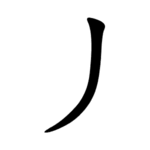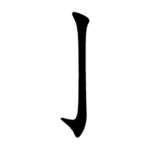Stroke (CJK character)
CJK strokes are the calligraphic strokes needed to write the Chinese characters in regular script used in East Asian calligraphy. CJK strokes are the classified set of line patterns that may be arranged and combined to form Chinese characters (also known as Hanzi) in use in China, Japan, and Korea.
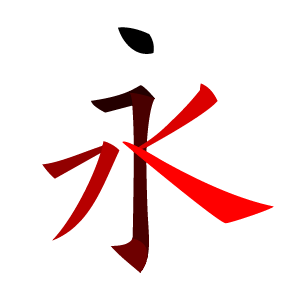
Purpose
The study and classification of CJK strokes aid in:
- understanding Chinese character calligraphy – the correct method of writing, shape formation and stroke order;
- understanding stroke changes according to the style that is in use;
- defining stroke naming and counting conventions;
- identifying fundamental components of Han radicals; and
- their use in computing.
Formation
When writing Han radicals, a single stroke includes all the motions necessary to produce a given part of a character before lifting the writing instrument from the writing surface; thus, a single stroke may have abrupt changes in direction within the line. For example:


Direction
All strokes have direction. They are unidirectional and start from one entry point. People should not write them in the reverse direction. Here are some examples:
Types
CJK strokes are an attempt to identify and classify all single-stroke components that can be used to write Han radicals. There are some thirty distinct types of strokes recognized in Chinese characters, some of which are compound strokes made from basic strokes. The compound strokes comprise more than one movement of the writing instrument, and many of these have no agreed-upon name.
Basic strokes
A basic stroke is a single calligraphic mark moving in one direction across a writing surface. The following table lists a selection of basic strokes divided into two stroke groups: simple and combining. "Simple strokes" (such as Horizontal / Héng and Dot / Diǎn) can be written alone. "Combining strokes" (such as Zig / Zhé and J hook / Gōu) never occur alone, but must be paired with at least one other stroke forming a compound stroke. Thus, they are not in themselves individual strokes.
| English Name | Name in PRC (pinyin and simp.) |
Name in ROC (pinyin and trad.) |
Name in Japan | CJK stroke |
Meaning of Chinese name (Japanese name, if different) |
Additional description |
|---|---|---|---|---|---|---|
| Simple strokes | ||||||
| Dot | Diǎn, 点 | Diǎn, 點 | Ten, 点 | "Dot" | Tiny dash, speck. | |
| Horizontal | Héng, 横 | Héng, 橫 | Yoko, 横 | "Horizontal" | Rightward stroke. | |
| Vertical | Shù, 竖 | Shù, 豎 | Tate, 豎 | "Vertical" | Downward stroke. | |
| Upward horizontal | Tí, 提 | Tiāo, 挑 | Hane, 跳 | "Rise" ("Jump") | Flick up and rightwards. | |
| Press | Nà, 捺 | Nà, 捺 | (Migi) Harai, (右)払 | "Press down" ("(Right) Sweep") | Falling rightwards (fattening at the bottom). | |
| Throw | Piě, 撇 | Piě, 撇 | (Hidari) Harai, (左)払 | "Throw away" ("(Left) Sweep") | Falling leftwards (with slight curve). | |
| Combining strokes | ||||||
| Zag | Zhé, 折 | Zhé, 折 | Ore, 折 | "Break" | Indicates change in stroke direction, usually 90° turn, going down or going right only. | |
| J hook | Gōu, 钩 | Gōu, 鈎(鉤) | Kagi, 鉤 | "Hook" | Appended to other strokes, suddenly going down or going left only. | |
| Clockwise curve | Wān, 弯 | Wān, 彎 | (Hidari) Sori, (左)反 | "Bend" ("(Left) Curve") | A tapering thinning curve, usually concave left (convex outward right). | |
| Anticlockwise curve | Xié, 斜 | Qū, 曲 | (Migi) Sori, (右)反 | "Slant" ("(Right) Curve") | Curved line, usually concave right (convex outward left). | |
Note, the basic stroke Diǎn "Dot" is rarely a real dot. Instead it usually takes the shape of a very small line pointing in one of several directions, and may be long enough to be confused with other strokes.
Compound strokes
.png)
A compound stroke (also called a complex stroke) is produced when two or more basic strokes are combined in a single stroke written without lifting the writing instrument from the writing surface. The character 永 (pinyin: yǒng) "eternity" described in more detail below demonstrates one of these compound strokes. The centre line is a compound stroke that combines three stroke shapes in a single stroke.
- Basics for making compound strokes[2]
In most cases, concatenating basic strokes together form a compound stroke. For example, Vertical / Shù combined with J hook / Gōu produce ![]()
An exception to this applies when a stroke makes a turn of 90° (and only of 90°) in the Simplified Chinese names. Horizontal ![]()
![]()
![]()
![]()
Nearly all complex strokes can be named using this simple scheme.
Nomenclature
Organization systems used to describe and differentiate strokes may include the use of roman letters, Chinese characters, numbers, or a combination of these devices. Two methods of organizing CJK strokes are by:
- Classification schemes that describe strokes by a naming convention or by conformity to a taxonomy; and
- Categorization schemes that differentiate strokes by numeric or topical grouping.
In classification schemes, stroke forms are described, assigned a representative character or letterform, and may be arranged in a hierarchy. In categorization schemes, stroke forms are differentiated, sorted and grouped into like categories; categories may be topical, or assigned by a numeric or alpha-numeric nominal number according to a designed numbering scheme.
- Benefits
Organizing strokes into a hierarchy aids a user's understanding by bringing order to an obtuse system of writing that has organically evolved over the period of centuries. In addition, the process of recognizing and describing stroke patterns promotes consistency of stroke formation and usage. When organized by naming convention, classification allows a user to find a stroke quickly in a large stroke collection, makes it easier to detect duplication, and conveys meaning when comparing relationships between strokes. When organized by numbering scheme, categorization aids a user in understanding stroke differences, and makes it easier to make predictions, inferences and decisions about a stroke.
- Limitations
Strokes are described and differentiated using the criteria of visual qualities of a stroke. Because this can require subjective interpretation, CJK strokes cannot be placed into a single definitive classification scheme because stroke types lack a universal consensus on the description and number of basic and compound forms. CJK strokes cannot be placed into a single definitive categorization scheme due to visual ambiguity between strokes, and therefore cannot be segregated into mutually-exclusive groups. Other factors inhibiting organization based on visual criteria is the variation of writing styles, and the changes of appearance that a stroke undergoes within various characters.
Roman letter naming convention of Unicode standard
A naming convention is a classification scheme where a controlled vocabulary is used systematically to describe the characteristics of an item. The naming convention for a CJK stroke is derived from the path mark left by the writing instrument. In this instance roman letters are concatenated to form a stroke name is a sequence of one or more roman letters indicating the component strokes used to create the CJK stroke. The first letter of the Han radical’s pinyin pronunciation represents each basic stroke. In a basic stroke example, H represents the stroke ![]()
While no consensus exists, there are up to 12 distinct basic strokes that are identified by a unique Han radical.
| Letter | B | D | G | H | N | P | Q | S | T | W | X | Z |
|---|---|---|---|---|---|---|---|---|---|---|---|---|
| Stroke direction | ||||||||||||
| Simp./Trad. | 扁 | 点/點 | 钩/鈎(鉤) | 横/橫 | 捺 | 撇 | 圈 | 竖/豎 | 提 | 弯/彎 | 斜 | 折 |
| Pinyin | Biǎn | Diǎn | Gōu | Héng | Nà | Piě | Quān | Shù | Tí | Wān | Xié | Zhé |
| Meaning | "Flat" | "Dot" | "Hook" | "Horizontal" | "Press down" | "Throw away" | "Circle" | "Vertical" | "Rise" | "Bend" | "Slant" | "Break" |
There are many CJK compound strokes, however there is no consensus for sequence letter naming of compound strokes using the basic strokes. The following table demonstrates the CJK stroke naming convention:
| Stroke | Name in PRC | Abbr[3][4] | Full Name | Dictionary meaning and Note | Example characters | Encoding |
|---|---|---|---|---|---|---|
| 横 | H | Héng | 一 yī, "cardinal number one", "alone" (Radical 1 一). | 二 三 丁 丞 丈 世 不 上 十 卅 七 | U+31D0 (㇐) | |
| 提 | T | Tí | 冰 淋 病 孑 治 冶 冽 暴 氾 录 地 虫 | U+31C0 (㇀) | ||
| 横钩 | HG | Héng Gōu | 乛 wān, ya, zhé (折) turning stroke / to break (Radical: Variant form of 乙 yǐ). | 疋 了 危 予 矛 子 字 令 疏 写 冖 | U+31D6 (㇖) | |
| 横撇 | HP | Héng Piě | 又 水 夕 径 炙 双 叒 今 | U+31C7 (㇇) | ||
| 横折 | HZ | Héng Zhé | 口 囗 己 田 品 吕 申 甲 圆 巪 | U+31D5 (㇕) | ||
| 横折钩 | HZG | Héng Zhé Gōu | (Radical: Variant form of 乙 yǐ). | 羽 习 包 勻 葡 用 青 甫 勺 月 也 乜 | U+31C6 (㇆) | |
| 横折提 | HZT | Héng Zhé Tí | 讠 计 鳩 | U+31CA (㇊) | ||
| 横折折 | HZZ | Héng Zhé Zhé | 凹 | U+31C5 (㇅) | ||
| 横折弯 | HZW | Héng Zhé Wān | 殳 投 朵 | U+31CD (㇍) | ||
| 横折弯钩[3] (横斜钩[4]) |
HZWG[3] (HXG[4]) |
Héng Zhé Wān Gōu[3] (Héng Xié Gōu[4]) |
Unofficial name "HWG" is used by Hugo Lopez[1]. | 飞 风 瘋 凬 虱 迅 气 九 几 | U+31C8 (㇈) | |
| 横斜弯钩[3] (横折弯钩[4]) |
HXWG[3] (HZWG[4]) |
Héng Xié Wān Gōu[3] (Héng Zhé Wān Gōu[4]) |
乙 yǐ, niè, "the second of the ten heavenly stems", "second"; zhé (折) turning stroke / to break (Radical 5 乙). | 氹 乞 乤 艺 | U+31E0 (㇠) | |
| 横折折折 | HZZZ | Héng Zhé Zhé Zhé | 凸 | U+31CE (㇎) | ||
| 横折折撇 | HZZP | Héng Zhé Zhé Piě | 建 及 | U+31CB (㇋) | ||
| 横撇弯钩 | HPWG | Héng Piě Wān Gōu | 阝 队 邮 | U+31CC (㇌) | ||
| 横折折折钩 | HZZZG | Héng Zhé Zhé Zhé Gōu | 𠄎 nǎi, archaic form of 乃 "then", "really, indeed", "namely", "you, your". | 乃 孕 仍 | U+31E1 (㇡) | |
| 竖 | S | Shù | 丨 gě, gǔn, "vertical line" (Radical 2 丨). | 丩 中 串 讧 乍 上 五 丑 | U+31D1 (㇑) | |
| 竖钩 | SG | Shù Gōu | 亅 jué, "a vertical line with a hook" (Radical 6 亅). | 爭 事 求 水 | U+31DA (㇚) | |
| 竖提 | ST | Shù Tí | 以 比 切 卯 食 良 艮 很 狠 鄉 民 | U+31D9 (㇙) | ||
| 竖折 | SZ | Shù Zhé | 断 陋 继 山 互 彙 牙 乐 东 | U+31D7 (㇗) | ||
| 竖弯 | SW | Shù Wān | 區 亡 妄 四 | U+31C4 (㇄) | ||
| 竖弯左 | SWZ | Shù Wān Zuǒ | 肅 嘯 蕭 簫 | U+31D8 (㇘) | ||
| 竖弯钩 | SWG | Shù Wān Gōu | 乚 yǐn, "hidden", "mysterious", "small", usually read as 隱 / 隐 yǐn (Radical: Variant form of 乙 yǐ). | 乱 己 已 巳 | U+31DF (㇟) | |
| 竖折折 | SZZ | Shù Zhé Zhé | 亞 鼎 卐 吳 专 | U+31DE (㇞) | ||
| 竖折弯钩[3] (竖折折钩[4]) |
SZWG[3] (SZZG[4]) |
Shù Zhé Wān Gōu[3] (Shù Zhé Zhé Gōu[4]) |
亏 强 弓 丏 丐 与 马 鸟 丂 号 | U+31C9 (㇉) | ||
| 撇 | P | Piě | 丿 usually read as 撇 piě, "line", "slash" (Radical 4 丿). | 乂 爻 禾 毛 乏 乖 釆 衣 八 行 | U+31D2 (㇒) | |
| 竖撇 | SP | Shù Piě | 乃 月 用 齊 几 人 班 大 | U+31D3 (㇓) | ||
| 撇钩 | PG | Piě Gōu | 乄 | U+31E2 (㇢) | ||
| 撇折 | PZ | Piě Zhé | 弘 玄 公 厶 翁 | U+31DC (㇜) | ||
| 撇点 | PD | Piě Diǎn | 𡿨 quǎn, a little drain between fields, usually read as 畎 quǎn (Radical 47 巛). | 女 巛 巡 獵 災 甾 | U+31DB (㇛) | |
| 点 | D | Diǎn | 丶 zhǔ, "dot", usually read as 點 / 点 diǎn (Radical 3 丶). | 丸 叉 义 永 冰 凡 丹 主 求 火 刃 | U+31D4 (㇔) | |
| 捺 | N | Nà | ㇏ usually read as 捺 nà. | 大 人 天 入 走 边 廷 尺 | U+31CF (㇏) | |
| 提捺 | TN | Tí Nà | (1) 乀 fú, "stretch". (2) 乁 yí, "to move" (archaic). | 尐 之 道 八 入 廻 | U+31DD (㇝) | |
| 斜钩 | XG | Xié Gōu | 戈 弋 戰 我 | U+31C2 (㇂) | ||
| 扁斜钩 | BXG | Biǎn Xié Gōu | 心 必 沁 惢 蕊 | U+31C3 (㇃) | ||
| 弯钩 | WG | Wān Gōu | 狐 狱 豹 家 啄 嶽 貓 家 逐 | U+31C1 (㇁) | ||
| 圈 | Q | Quān | 〇 líng, "zero"; also read as 圈 quān, "circle". | 〇 㔔 㪳 㫈 | U+31E3 (㇣) |
Besides, some strokes have been unified or abandoned in Unicode:
| Stroke | Name in PRC | Abbr | Full Name | Note | Example characters |
|---|---|---|---|---|---|
| 横撇弯 | HPW[1] | Héng Piě Wān | It only appears in Regular script, can be merged into stroke HPHP in Song typeface. | 辶 过 边 | |
| 竖折撇 | SZP[4] | Shù Zhé Piě | This stroke has been merged into stroke SZZ in Unicode.[5] | 专 𧦮 𤓷 𤦡 | |
| 竖折折弯钩 | SZZWG[1] | Shù Zhé Zhé Wān Gōu | This stroke has been merged into stroke SZZG in Unicode.[5] | 弓 丐 | |
| 弯 | W[1] | Wān | It never occurs alone, only appears inside compound strokes. | 辶 豕 𢀓 | |
| 弯钩 | WG[1] | Wān Gōu | It never occurs alone, only appears inside compound strokes. | 乙 | |
| 点捺 | DN[4] | Diǎn Nà | This stroke has been merged into stroke TN or N in Unicode.[5] | 內 全 廴 | |
| 平捺 | PN[4] | Píng Nà | This stroke has been merged into stroke N in Unicode.[5] | 是 走 廴 | |
| 提平捺 | TPN[4] | Tí Píng Nà | This stroke has been merged into stroke N in Unicode.[5] | 辶 之 辷 |
Notice that some names in the list have not followed the rules of controlled vocabulary. For example, stroke P is not found in the compound stroke PN. The name "PN" comes from 平捺 (pinyin: Píng Nà), not 撇捺 (pinyin: Piě Nà). The meaning of 平 (pinyin: Píng) is flat. So we should call it "BN" 扁捺 (pinyin: Biǎn Nà) if we follow the rule strictly. Letter "Z" in stroke SWZ means 左 (pinyin: Zuǒ), not 折 (pinyin: Zhé). The meaning of 左 is "left", it is not defined in the naming convention. Moreover, some 折 (pinyin: Zhé) are far more than or far less than 90°, such as stroke HZZZG, stroke HZZP and stroke PZ.
Some strokes are not included in the Unicode standard, such as stroke ![]()
![]()
![]()
![]()
![]()
![]()
In Simplified Chinese, stroke TN ![]()
![]()
Abbreviation form naming convention of inherited names
On the other hand, naming convention that use abbreviation form of the CJK strokes is also created. After the names of CJK strokes are translated into English, first letters of the English names are used in the naming system. We can divide the controlled vocabulary into two groups.
The first group is Abbreviation form of the basic strokes.
| Abbr form | H | V | T | P | D | U | C | A | J | O |
|---|---|---|---|---|---|---|---|---|---|---|
| Shape of stroke | ||||||||||
| English name | Horizontal | Vertical | Throw | Press | Dot | Upward horizontal | Clockwise curve | Anticlockwise curve | J hook | Oval |
| Chinese name | 橫 | 豎 | 撇 | 捺 | 點 | 挑 | 彎 | 曲 | 鈎 | 圈 |
The second group is Abbreviation form of deformations.
| Abbr form | F | W | S | L | R | E | N | I | M | Z |
|---|---|---|---|---|---|---|---|---|---|---|
| Deformation | ||||||||||
| English name | Flat | Wilted | Slanted | Left | Right | Extended | Narrowed | Inverted | Mirrored | Zag |
| Chinese name | 扁 | 直 | 斜 | 左 | 右 | 長 | 短 | 倒 | 反 | 折 |
“Zig” can be omitted in the naming system. The following table demonstrates the CJK stroke naming convention:
| Stroke | Chinese name | Abbr form | Full name | Name in Unicode | Example | |
|---|---|---|---|---|---|---|
| Ming | Kai | |||||
| 橫 | H | Horizontal | H | 三 言 隹 花 | ||
| 斜橫 | SH | Slanted Horizontal | (H) | 七 弋 宅 戈 | ||
| 挑 | U | Upward horizontal | T | 刁 求 虫 地 | ||
| 點挑 | DU | Dot – Upward horizontal | (T) | 冰 冷 汗 汁 | ||
| 豎 | V | Vertical | S | 十 圭 川 仆 | ||
| 斜豎 | SV | Slanted Vertical | (S) | 丑 五 亙 貫 | ||
| 右斜豎 | RSV | Right Slanted Vertical | (S) | 𠙴 | ||
| 撇 | T | Throw | P | 竹 大 乂 勿 | ||
| 扁撇 | FT | Flat Throw | (P) | 千 乏 禾 斤 | ||
| 直撇 | WT | Wilted Throw | SP | 九 厄 月 几 | ||
| 點 | D | Dot | D | 主 卜 夕 凡 | ||
| 長點 | ED | Extended Dot | (D) | 囪 囟 这 凶 | ||
| 左點 | LD | Left Dot | (D) | 心 忙 恭 烹 | ||
| 直點 | WD | Wilted Dot | (D) | 六 文 宇 空 | ||
| 捺 | P | Press | N | 人 木 尺 冬 | ||
| 挑捺 | UP | Upward horizontal – Press | TN | 文 廴 父 爻 | ||
| 橫捺 | HP | Horizontal – Press | (TN) | 入 八 內 全 | ||
| 扁捺 | FP | Flat Press | (N) | 走 足 廴 麵 | ||
| 挑扁捺 | UFP | Upward horizontal – Flat Press | (TN) | 之 乏 巡 迴 | ||
| 彎 | C | Clockwise curve | W | |||
| 曲 | A | Anticlockwise curve | X | |||
| 圈 | O | Oval | Q | 〇 㔔 㪳 㫈 | ||
| 橫鈎 | HJ | Horizontal – J hook | HG | 冧 欠 冝 蛋 | ||
| 挑鈎 | UJ | Upward horizontal – J hook | (HG) | 也 乜 池 馳 | ||
| 橫撇 | HT | Horizontal – Throw | HP | 夕 水 登 令 | ||
| 橫斜 | HSV | Horizontal – Slanted Vertical | (HP) | 今 彔 互 恆 | ||
| 橫豎 | HV | Horizontal – Vertical | HZ | 口 己 臼 典 | ||
| 橫豎鈎 | HVJ | Horizontal – Vertical – J hook | HZG | 而 永 印 令 | ||
| 橫撇鈎 | HTJ | Horizontal – Throw – J hook | (HZG) | 勺 方 力 母 | ||
| 挑撇鈎 | UTJ | Upward horizontal – Throw – J hook | (HZG) | 也 乜 池 馳 | ||
| 橫豎橫 | HVH | Horizontal – Vertical – Horizontal | HZZ | 凹 兕 卍 雋 | ||
| 橫豎挑 | HVU | Horizontal – Vertical – Upward horizontal | HZT | 殼 鸠 说 计 | ||
| 橫曲 | HA | Horizontal – Anticlockwise curve | HZW | 朵 沿 殳 没 | ||
| 橫曲鈎 | HAJ | Horizontal – Anticlockwise curve – J hook | HZWG | 九 几 凡 亢 | ||
| 橫捺鈎 | HPJ | Horizontal – Press – J hook | (HZWG) | 風 迅 飛 凰 | ||
| 橫撇曲鈎 | HTAJ | Horizontal – Throw – Anticlockwise curve – J hook | HXWG | 乙 氹 乞 乭 | ||
| 橫撇彎 | HTC | Horizontal – Throw – Clockwise curve | --- | 過 过 這 这 | ||
| 橫撇橫撇 | HTHT | Horizontal – Throw – Horizontal – Throw | HZZP | 延 建 巡 及 | ||
| 橫撇彎鈎 | HTCJ | Horizontal – Throw – Clockwise curve – J hook | HPWG | 陳 陌 那 耶 | ||
| 橫豎橫豎 | HVHV | Horizontal – Vertical – Horizontal – Vertical | HZZZ | 凸 𡸭 𠱂 𢫋 | ||
| 橫撇橫撇鈎 | HTHTJ | Horizontal – Throw – Horizontal – Throw – J hook | HZZZG | 乃 孕 仍 盈 | ||
| 豎挑 | VU | Vertical – Upward horizontal | ST | 卬 氏 衣 比 | ||
| 豎橫 | VH | Vertical – Horizontal | SZ | 山 世 匡 直 | ||
| 豎曲 | VA | Vertical – Anticlockwise curve | SW | 區 亡 四 匹 | ||
| 豎曲鈎 | VAJ | Vertical – Anticlockwise curve – J hook | SWG | 孔 已 亂 也 | ||
| 豎橫豎 | VHV | Vertical – Horizontal – Vertical | SZZ | 鼎 亞 吳 卐 | ||
| 豎橫撇 | VHT | Vertical – Horizontal – Throw | (SZZ) | 奊 捑 𠱐 𧦮 | ||
| 豎橫撇鈎 | VHTJ | Vertical – Horizontal – Throw – J hook | SZWG | 弓 弟 丐 弱 | ||
| 豎鈎 | VJ | Vertical – J hook | SG | 小 水 到 寸 | ||
| 豎彎 | VC | Vertical – Clockwise curve | SWZ | 肅 嘯 蕭 瀟 | ||
| 豎彎鈎 | VCJ | Vertical – Clockwise curve – J hook | --- | 𨙨 𨛜 𨞠 𨞰 | ||
| 撇挑 | TU | Throw – Upward horizontal | PZ | 去 公 玄 鄉 | ||
| 撇橫 | TH | Throw – Horizontal | (SZ) | 互 母 牙 车 | ||
| 撇點 | TD | Throw – Dot | PD | 巡 兪 巢 粼 | ||
| 直撇點 | WTD | Wilted Throw – Dot | (PD) | 女 如 姦 㜢 | ||
| 撇橫撇 | THT | Throw – Horizontal – Throw | (SZZ) | 夨 𠨮 专 砖 | ||
| 撇橫撇鈎 | THTJ | Throw – Horizontal – Throw – J hook | (SZWG) | 巧 亟 污 號 | ||
| 撇鈎 | TJ | Throw – J hook | PG | 乄 | ||
| 彎鈎 | CJ | Clockwise curve – J hook | WG | 狗 豸 豕 象 | ||
| 扁捺鈎 | FPJ | Flat Press – J hook | BXG | 心 必 沁 厯 | ||
| 捺鈎 | PJ | Press – J hook | XG | 弋 戈 我 銭 | ||
| 撇橫撇曲鈎 | THTAJ | Throw – Horizontal – Throw – Anticlockwise curve – J hook | --- | 𠃉 𦲳 𦴱 鳦 | ||
| 撇圈點 | TOD | Throw – Oval – Dot | --- | 𡧑 𡆢 | ||
Numbering scheme
A numbering scheme is a categorization method where like-item strokes are grouped into categories labeled by nominal numbers. Category numbering may be an index of numbers of types, with sub-types indicated by decimal point followed by another number or a letter.[4]
The following table is a common numbering scheme that uses similar names as the roman letter naming convention, but the stroke forms are grouped into major category types (1 to 5), which further break down into 25 sub-types in category 5.
|
| ||||||||||||||||||||||||||||||||||||||||||||||||||||||||||||||||||||||||||||||||||||||||||||||||||||||||||||||||||||||||||||||||||||
Some strokes are not included in the numbering scheme, such as stroke ![]()
![]()
![]()
![]()
![]()
![]()
![]()
![]()
Besides, ways of grouping strokes are different from the Unicode standard. For example, stroke ![]()
![]()
![]()
Stroke order
Stroke order refers to the order in which the strokes of a Chinese character are written. A stroke is a movement of a writing instrument on a writing surface. Because most Chinese characters have many strokes, certain stroke orders guidelines are recommended to ensure speed, accuracy, and legibility in composition. Also, teachers enforce exactly one stroke order for each character, marking every deviation as a mistake, so everyone writes these characters the same way. The stroke order follows a few simple rules, though, which aids in memorizing these. To write CJK characters, one must know how to write CJK strokes, and thus, needs to identify the basic strokes that make up a character.
Eight Principles of Yong
The Eight Principles of Yong explain how to write eight common strokes in regular script which are found all in the one character, 永 (pinyin: yǒng, "forever", "permanence"). It was traditionally believed that the frequent practice of these principles as a beginning calligrapher could ensure beauty in one's writing.
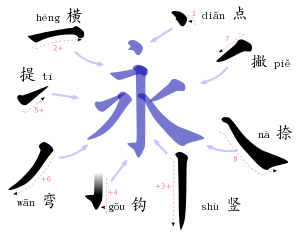
- Eight basic strokes[2]








- (+

 |  |  |  |  |  |  |  | ( |
Use in computing
The stroke count method is based on the order of strokes to input characters on Chinese mobile phones.
As part of Chinese character encoding, there have been several proposals to encode the CJK strokes, most of time with a total around 35~40 entries. Most notable is the current Unicode block “CJK Strokes” (U+31C0..U+31EF), with 36 types of strokes:
| CJK Strokes[1][2] Official Unicode Consortium code chart (PDF) | ||||||||||||||||
| 0 | 1 | 2 | 3 | 4 | 5 | 6 | 7 | 8 | 9 | A | B | C | D | E | F | |
| U+31Cx | ㇀ | ㇁ | ㇂ | ㇃ | ㇄ | ㇅ | ㇆ | ㇇ | ㇈ | ㇉ | ㇊ | ㇋ | ㇌ | ㇍ | ㇎ | ㇏ |
| U+31Dx | ㇐ | ㇑ | ㇒ | ㇓ | ㇔ | ㇕ | ㇖ | ㇗ | ㇘ | ㇙ | ㇚ | ㇛ | ㇜ | ㇝ | ㇞ | ㇟ |
| U+31Ex | ㇠ | ㇡ | ㇢ | ㇣ | ||||||||||||
| Notes | ||||||||||||||||
See also
- Chinese characters description languages
References
- Lopez, Hugo (2007). "CJK 37 Strokes (fr:Traits chinois)".
- The extended CJK(V) set of strokes has 29 strokes. These most common 29 used strokes can be reduced to combinations of 8 basic strokes, for a total of 37 strokes. The subset of 8 is found in the character "eternity" 永, hence the name of this set. But other sets of CJK(V) strokes can be found.
- Proposed additions to the CJK Strokes block of the UCS (PDF), Ideographic Rapporteur Group, April 3, 2006; Documentation of CJK Strokes (Version 11.0) (PDF), The Unicode Standard / the Unicode Consortium, June 1, 2018
- Bishop, Tom; Cook, Richard (May 23, 2004), Character Description Language (CDL): The Set of Basic CJK Unified Stroke Types (PDF), Wenlin Institute, p. 8
- IRGN 1174: Summary Report of Strokes Ad Hoc Group, Strokes Ad Hoc Group, December 1, 2005; Documentation of CJK Strokes (Version 11.0) (PDF), The Unicode Standard / the Unicode Consortium, June 1, 2018
- "《GB13000.1字符集汉字折笔规范》" (PDF) (in Chinese). 中华人民共和国教育部 国家语言文字工作委员会. December 19, 2001.
External links
| Wikimedia Commons has media related to CJK strokes. |
- Unicode: CJK Strokes, Range: 31C0–31EF — set of 36 CJK strokes
- The Unicode Standard Core Specification: Appendix F - Documentation of CJK Strokes
- Proposal to add twenty strokes to Unicode; this proposal has been approved and is at Stage 6 of the Unicode Pipeline as of July 30, 2007.
- Standardization documents of Inherited Glyphs: List of Strokes for Inherited Glyphs
- Ministry of Education, R.O.C.: Grouping list of CJK Strokes
- State Language Commission, P.R.C.: Chinese Character Component Standard of GB 13000.1 Character Set for Information Processing
- State Language Commission, P.R.C.: Chinese Character Turning Stroke Standard of GB 13000.1 Character Set
- 38 CJK strokes, by Wenlin Institute
- Tom Bishop, Richard Cook: Character Description Language (CDL): The Set of Basic CJK Unified Stroke Types
- Yannis Haralambous: Seeking Meaning in a Space Made out of Strokes, Radicals, Characters and Compounds
- Yannis Haralambous: Fonts & Encodings O'Reilly Media Inc., Sept 26 2007, p.154-156
